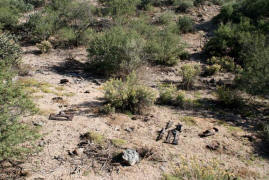|
|

B-24D # 41-23821 crashed December 4, 1942 near Kelvin, AZ
Summary: In the early afternoon of December 4, 1942, a B-24 Liberator departed Davis-Monthan Field in Tucson for a navigational flight. As they took a course northward toward Florence, Arizona, they noticed thunderheads in the distance. About five miles southwest of Kelvin, the skies were filled with overcast and low-hanging rain clouds that obscured the 3,000 foot mountain peaks. By 2 pm, the heavy rain had subsided and the base of the dark clouds had risen to 6,000 feet. Soon after, the loud rumble of an USAAF bomber's radial engines filled the sky. A few people in the area looked up and noticed a piece of aircraft falling from the cloudbank. Immediately afterwards, the large olive-drab painted bomber dropped from the clouds and began a series of wide, slow circles. One witness noticed that the bomber was missing the right-hand tail assembly as it flew near her house. As she watched it fly away, it began climbing and diving, before finally climbing one last time, stalling, and crashing to the ground. Investigators concluded that while the bomber was flying in the overcast at an altitude above 9,000 feet, it encountered strong turbulence. The turbulence was violent enough to have caused enough severe upward pressure on the right-hand tail assembly that caused it to fracture and break free of the aircraft. The turbulence further weakened the tension and stability of the left-hand tail assembly, which caused the bomber to fall into a spin as it descended from the clouds. However, there was just enough stability in the left tail assembly to allow Lt. Adams to have only partial control of the bomber. As he recovered from the spin, only 1,000 feet above the desert terrain, he had sufficient control to fly in a southeast heading. However, the aircraft became unmanageable and began climbing and stalling, before crashing. Searchers combed the steep cactus-covered hills and deep canyons and finally located several broken sections of the right-hand tail assembly and rudder scattered over a mile from where the bomber had crashed. The seven-man crew was Lt. Robert Adams, pilot; Lt. Arthur Eidson, copilot; Sgt. James Akins, engineer; S/Sgt. Francis Santmyer, radio operator; Sgt. Armand Peltier, gunner; Pvt.Edward Zeintarski, radio/ gunner; Pvt. Milton Keinholz, gunner. |
 |
 |
 |
| The 22 year-old pilot, Lt. Robert Adams. | Sgt. Armand Peltier, one of five brothers who went to war. Tragically, his brother was killed in another B-24 accident in May, 1943 while in England. | S/Sgt Francis Santmyer, a 26 year old radio operator. |
 |
 |
| A 1942 USAAF crash photo of the fuselage- note the 50 cal gun in the debris. | Same angle almost 70 years later. |
 |
 |
| A close up of Engine 1 (right) and Engine 2 (left). | Same angle- only molten aluminum and steel fragments remain. |
 |
 |
 |
 |
| An overview photo of the general crash area. | The area is full of rattlesnakes, like this one. | Main impact area. | A .50 cal ammo canister from one of the turret guns. |
 |
 |
 |
 |
| More debris. | Stainless steel bomb shackles. | Main fuselage burn area. | A few data plates. |